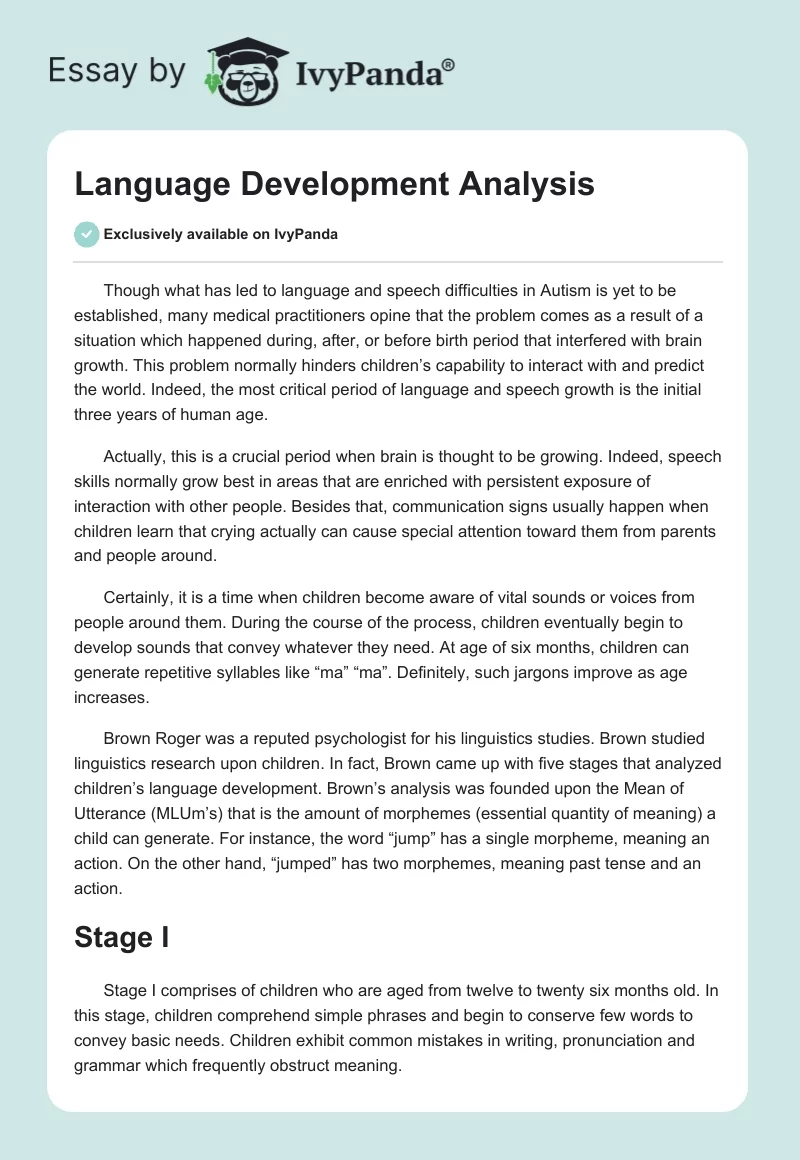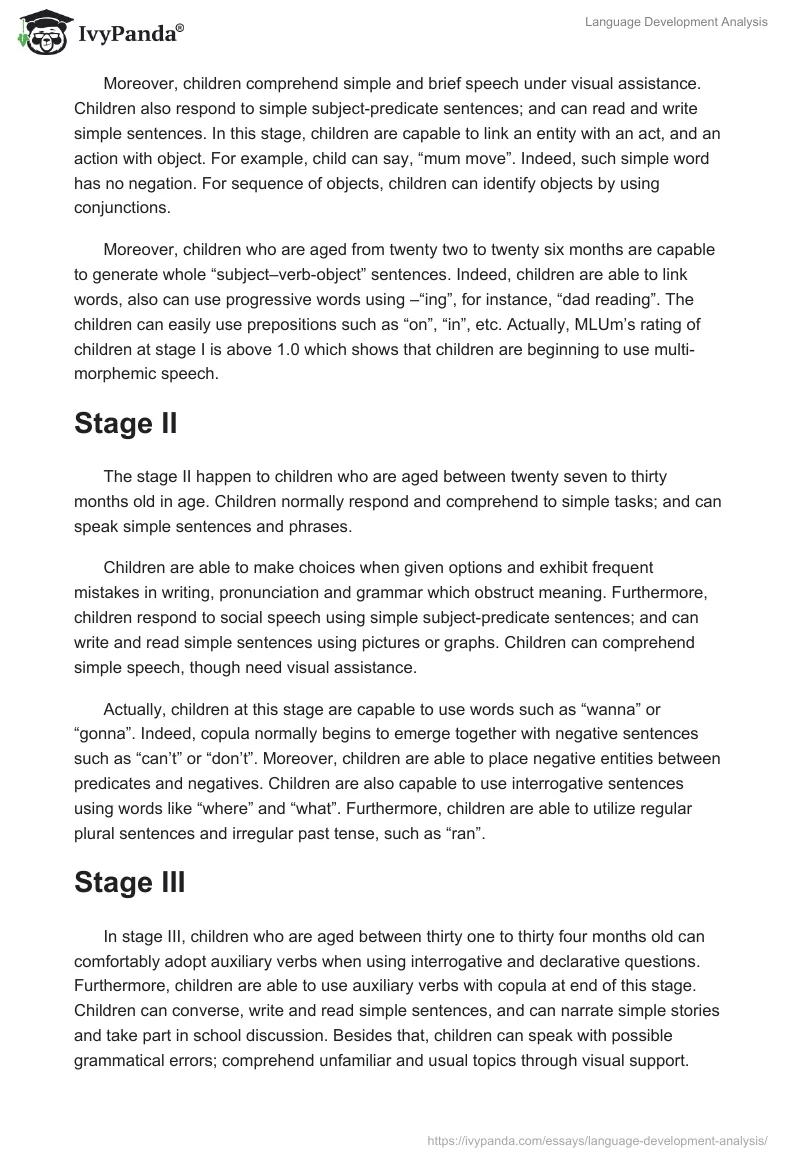Though what has led to language and speech difficulties in Autism is yet to be established, many medical practitioners opine that the problem comes as a result of a situation which happened during, after, or before birth period that interfered with brain growth. This problem normally hinders children’s capability to interact with and predict the world. Indeed, the most critical period of language and speech growth is the initial three years of human age.
Actually, this is a crucial period when brain is thought to be growing. Indeed, speech skills normally grow best in areas that are enriched with persistent exposure of interaction with other people. Besides that, communication signs usually happen when children learn that crying actually can cause special attention toward them from parents and people around.
Certainly, it is a time when children become aware of vital sounds or voices from people around them. During the course of the process, children eventually begin to develop sounds that convey whatever they need. At age of six months, children can generate repetitive syllables like “ma” “ma”. Definitely, such jargons improve as age increases.
Brown Roger was a reputed psychologist for his linguistics studies. Brown studied linguistics research upon children. In fact, Brown came up with five stages that analyzed children’s language development. Brown’s analysis was founded upon the Mean of Utterance (MLUm’s) that is the amount of morphemes (essential quantity of meaning) a child can generate. For instance, the word “jump” has a single morpheme, meaning an action. On the other hand, “jumped” has two morphemes, meaning past tense and an action.
Stage I
Stage I comprises of children who are aged from twelve to twenty six months old. In this stage, children comprehend simple phrases and begin to conserve few words to convey basic needs. Children exhibit common mistakes in writing, pronunciation and grammar which frequently obstruct meaning.
Moreover, children comprehend simple and brief speech under visual assistance. Children also respond to simple subject-predicate sentences; and can read and write simple sentences. In this stage, children are capable to link an entity with an act, and an action with object. For example, child can say, “mum move”. Indeed, such simple word has no negation. For sequence of objects, children can identify objects by using conjunctions.
Moreover, children who are aged from twenty two to twenty six months are capable to generate whole “subject–verb-object” sentences. Indeed, children are able to link words, also can use progressive words using –“ing”, for instance, “dad reading”. The children can easily use prepositions such as “on”, “in”, etc. Actually, MLUm’s rating of children at stage I is above 1.0 which shows that children are beginning to use multi-morphemic speech.
Stage II
The stage II happen to children who are aged between twenty seven to thirty months old in age. Children normally respond and comprehend to simple tasks; and can speak simple sentences and phrases.
Children are able to make choices when given options and exhibit frequent mistakes in writing, pronunciation and grammar which obstruct meaning. Furthermore, children respond to social speech using simple subject-predicate sentences; and can write and read simple sentences using pictures or graphs. Children can comprehend simple speech, though need visual assistance.
Actually, children at this stage are capable to use words such as “wanna” or “gonna”. Indeed, copula normally begins to emerge together with negative sentences such as “can’t” or “don’t”. Moreover, children are able to place negative entities between predicates and negatives. Children are also capable to use interrogative sentences using words like “where” and “what”. Furthermore, children are able to utilize regular plural sentences and irregular past tense, such as “ran”.
Stage III
In stage III, children who are aged between thirty one to thirty four months old can comfortably adopt auxiliary verbs when using interrogative and declarative questions. Furthermore, children are able to use auxiliary verbs with copula at end of this stage. Children can converse, write and read simple sentences, and can narrate simple stories and take part in school discussion. Besides that, children can speak with possible grammatical errors; comprehend unfamiliar and usual topics through visual support.
Moreover, children can respond to social speech using complex sentences, and can read and write complex sentences using picture and graphs. Children also exhibit fairly common mistakes in writing, grammar and pronunciation which obstruct meaning. Moreover, children can use conjunctions like “but”, “or”, “so” etc. Besides that, children can use “won’t” in negative sentences. Furthermore, children also adopt regular past tense, articles and possessives when forming sentences.
Stage VI
At this stage, children are developing close to indigenous proficiency in English and take part in complex learning tasks with few grammatical mistakes. Children also can exhibit some mistakes in writing, grammar and pronunciation which do not obstruct meaning. Children can comprehend both academic and social speech; though need visual assistance for unusual topics.
Children can respond to academic learning and social speech using complex sentences and developed vocabulary; and can read complex texts through use of pictures and graphs. Moreover, children who are aged between thirty five to forty months old are under this stage. Indeed, children are capable to use double auxiliary verbs in declarative sentences. Actually, children are able to employ such verbs when negating sentences such as “didn’t”, “isn’t” or “doesn’t”.
Besides that, children are capable to use interrogative sentences using words such as “how” and “when”. Both infinitive and inquiry phrases are comfortably used at the end of sentences and also the use of “because” in order to explain a “cause and impact” of an action. This is the stage when children learn several capabilities which led to development of their pragmatic competences.
Stage V
Under this stage, children can write, converse and read English in such a way that resemble indigenous English speakers and take part in school activities actively. Children also can exhibit minimal mistakes in writing, grammar and pronunciation which do not obstruct meaning.
Children can effectively communicate using broad range of topics, and can comprehend both academic and social speech effectively. Furthermore, children can respond to academic learning and social speech using variety of sentences and enriched vocabulary; and can independently write and read technical text. Indeed, these are children who are aged between forty-one to forty-six months old; are able to employ indirect objects in sentences.
Actually, children are capable to use “shouldn’t”, “wasn’t”, wouldn’t” etc. In fact, children are able to use relative clauses to form complex sentences. Certainly, both regular and irregular third persons are easily used when forming sentences. Furthermore, children have enhanced speech and also learn vital concept like third person pronouns which develop their pragmatic capabilities.
Language Development
Brown’s language analysis offered a comprehensive structure in predicting and knowing the course which growth of expressive language normally takes. Indeed, syntax and morphology are common terms that are used by language psychologists when performing structural psychotherapy of children’s speech.
Actually, this particular language development analysis includes examination of child’s progress in aspect such as “pronunciation clarity” and “speech sound”. Indeed, such analysis looks into phonetic assessment; how children generate “speech sound”. Moreover, phonological assessment is also analyzed in terms of the manner sounds are structured.
Indeed, morphology is a linguistics concept that is a branch of grammar which is committed to study framework of words, basically through adoption of morpheme construct. Actually, morphology is a different concept from syntax. Indeed, syntax is a linguistic term that studies regulation which governs word linkages in order to build sentences. Definitely, this is how syntax and morphology are different. Besides that, morpheme refers to the unit of word meaning.
Nevertheless, this is not associated with syllable count or word count of speech. Indeed, the following is an illustration of how morpheme can be counted. For example, the word “happy” is only one word that has two syllables. In fact, happy only has one unit of meaning. Therefore it has only one morpheme. On the other hand, unhappy is one word though is has three syllables, which is “un”-“ha”-“ppy”.
Actually unhappy has two morphemes; this is “un” and “happy”. Moreover, unhappily is just a single word, that has four syllables, such has un-happy-i-ily. Unhappily is a word that has three morpheme, “un”, “happy” and “ly”. Besides that unhappiest is only one word, that has four syllables but with three morphemes. For example, a sentence like, “Mary encounters the unhappiest girls” is a sentence that has five words, containing eight syllables and nine morphemes: “Mary” “encounter’-“s” “the” “un”-“happi”-“est” “girl”-“s”.
Conclusion
The MLUm (Mean Length of Utterance measured in Morphemes) is a technique that measures competence of children’s morphemes. For example, children aged between fifteen to thirty months have 1.75 morphemes. Actually, it is important to note that as MLUm progress, the level language generated also increases. This is to say that as MLUm develops, children’s competence to use and know grammatical structures also progresses.


